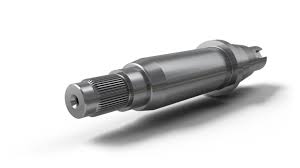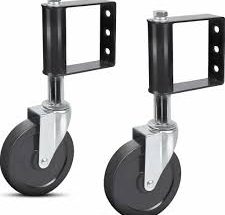Motor Shafts: Types, Sizes, and Functions
Motor shafts are the unsung heroes in mechanical engineering, essential for the functionality and efficiency of a wide array of machinery. Often overlooked, these critical components ensure the smooth operation of equipment across various industries. From small household appliances to huge industrial machines, the role of motor shafts is irreplaceable in ensuring mechanical integrity and performance.
In today’s digital age, understanding the intricacies of motor shafts is more than just a matter of mechanical proficiency. It’s also about leveraging digital marketing agency services to disseminate this knowledge effectively. This article aims to bridge the gap, offering insights into motor shaft types, sizes, and functions crafted explicitly for engineers, technicians, and those invested in machinery design and maintenance.
What is a Motor Shaft?
Understanding what a motor shaft is and its role in machinery is fundamental for anyone involved in mechanical engineering or maintenance.
Here are the key aspects:
-
Cylindrical Component
A motor shaft is typically a cylindrical piece central to the design of many mechanical systems.
-
Energy Conversion
It plays a vital role in converting electric energy into rotational force, which is crucial for machine operation.
-
Linkage Role
Acts as a pivotal link, connecting the motor to various mechanical components, thus enabling motion and function.
These points illustrate a motor shaft’s essential characteristics and functions, highlighting its importance in mechanical applications.
Types of Motor Shafts
The diversity in motor shaft designs is vital to their application across different machinery. Each type of motor shaft is engineered to meet specific operational demands, ranging from basic household appliance tasks to complex industrial functions.
Here’s a breakdown of the common types:
-
Solid Shaft
Standard in many applications, solid shafts offer rigidity and strength. It is ideal for general-purpose use in motors where torsional strength is a priority.
-
Hollow Shaft
It is lighter and often used in applications where weight reduction is essential. Hollow shafts facilitate ease in maintenance and allow additional components to be passed through their center.
-
Splined Shaft
Features a series of ridges or teeth on a drive shaft web with grooves in the mating piece. This design is commonly used for more precise torque transfer, particularly in automotive applications.
-
Keyed Shaft
Includes a keyway and a key that engage with a corresponding component to prevent rotation between the two parts. Widely used in industrial motors where secure attachment is necessary.
-
Threaded Shaft
Comes with a threaded exterior, often employed in precision applications such as positioning systems, where controlled, fine movement is required.
Understanding these types and their specific applications is crucial in selecting the most suitable motor shaft for your machinery needs.
Motor Shaft Sizes and Dimensions
Selecting the correct motor shaft size is pivotal for optimal machinery performance. The dimensions of a shaft must be carefully matched with the motor’s power output and the specific demands of the machinery it operates.
In this section, we explore various aspects of motor shaft dimensions:
-
Standard Sizes
Motor shafts are available in various standard sizes to suit different applications. These sizes are typically based on the power capacity and type of motor.
-
Custom Sizes
Custom-sized shafts can be manufactured for unique applications or specialized machinery. These are tailored to specific requirements where standard sizes may not suffice.
-
Diameter Considerations
The diameter of a motor shaft affects its torque capacity and strength. Larger diameters generally allow for higher torque transmission.
-
Length Variations
Shaft length can influence the space requirements and configuration of the machinery. Longer shafts may be necessary for specific designs but can also introduce troubles regarding alignment and stability.
-
Impact on Performance
The size and dimensions of a motor shaft directly impact its performance. Incorrect sizing can lead to inefficiencies, increased wear and tear, and potential machinery failure.
By understanding these essential aspects, engineers and technicians can ensure they select the right motor shaft size for their specific machinery needs, ensuring the efficiency and longevity of their equipment.
Specialized Motor Shafts
Motor shafts are not a one-size-fits-all component; they are meticulously engineered to meet specific application needs.
Here’s a closer look at some of the specialized motor shafts:
- Electric Motor Shafts
- Designed for optimal electrical efficiency.
- This is common in applications where electrical performance is paramount.
- Engineered to lessen energy loss and maximize output.
- Gear Motor Shafts
- Specifically tailored for gear systems.
- Built to accommodate various gear types and sizes.
- Focus on durability and precise power transmission.
Each specialized motor shaft type brings unique advantages to the table, catering to the specific demands of different machinery and applications.
Shaft Coupling for Motors
Shaft coupling in motor systems is crucial for a seamless transfer of power. It compensates for misalignment and absorbs shocks and vibrations, ensuring the longevity and efficiency of the motor.
Here’s a quick guide to the different types of shaft couplings:
-
Rigid Couplings
Ideal for precise shaft alignment, rigid couplings are used in scenarios where shafts are already co-linear. They are simple in design and offer a direct connection but need more flexibility.
-
Flexible Couplings
Designed to tolerate misalignment, these couplings are essential in applications where shafts are likely to shift. They reduce stress on the motor and shaft by accommodating angular, parallel, and axial misalignments.
-
Elastomeric Couplings
These couplings are significant for dampening shocks using elastic materials to absorb vibrations. They offer flexibility and are maintenance-free, suitable for various applications.
-
Gear Couplings
With high torque density, gear couplings are perfect for heavy-duty applications. They can accommodate both angular and parallel misalignments but require periodic maintenance.
-
Universal Joints
These are used for applications requiring significant shaft misalignments. They offer high flexibility but are less efficient at higher speeds due to increased vibration.
Each type of coupling serves a unique purpose, and selecting the right one depends on your specific motor and machinery requirements.
Motor Shaft Alignment
Achieving perfect motor shaft alignment is not just a technical requirement but a necessity for prolonging the life and efficiency of machinery. This section sheds light on the critical aspects of the alignment process, ensuring that machinery operators and technicians can maintain optimal operation with minimal wear and tear.
Key points include:
-
Alignment Basics
Understanding the fundamental principle that motor and driven equipment shafts must be collinear for efficient operation.
-
Measurement Techniques
Utilizing advanced tools like laser alignment systems or traditional methods like dial indicators to measure misalignment accurately.
-
Types of Misalignment
Understanding their impacts includes Identifying misalignment types, such as angular, parallel, or combination.
-
Alignment Tools
Selection of the right tools, including laser aligners, dial indicators, or straightedges, tailored to specific machinery requirements.
-
Correction Methods
Implementing techniques such as shimming or adjusting bolt torques to realign shafts precisely.
-
Verification
Double-checking alignment post-adjustment to confirm accuracy and ensure long-term machinery health.
By adhering to these fundamental steps and utilizing the appropriate tools, the alignment of motor shafts can be executed with precision, significantly enhancing the lifespan and performance of machinery.
Motor Shaft Extensions and Modifications
Motor shafts are often customized to meet the unique demands of different machinery. These customizations, ranging from extensions to various modifications, ensure ideal performance and compatibility.
Below are critical aspects of motor shaft extensions and modifications:
-
Extension Necessity
Extensions are typically required when the existing shaft length is insufficient for new or modified equipment setups. They help bridge the gap between the motor and the machinery it drives.
-
Custom Modifications
Modifications can include changes in diameter, surface finishing, or adding specific features like keyways or threads. These alterations are crucial for specialized applications.
-
Compatibility and Performance
Ensuring that the modified shaft matches the motor specifications and operational requirements is vital for maintaining performance and preventing mechanical failures.
-
Implementation Techniques
Techniques such as welding, machining, and extension couplings are employed to execute these modifications. Each method has specific advantages and is chosen based on the shaft material and intended application.
Maintenance and Repair
Proper upkeep and timely intervention are vital to the longevity and efficiency of motor shafts. Regular maintenance extends the lifespan of these critical components and ensures optimal performance of the machinery they drive.
Below are essential tips and techniques for maintaining and repairing motor shafts:
-
Routine Inspection
Regularly check motor shafts for signs of wear, corrosion, or misalignment. Early detection of issues can prevent more notable problems down the line.
-
Lubrication
Apply suitable lubricants to reduce friction and wear. This is especially crucial for shafts under heavy use or in high-friction environments.
-
Alignment Checks
Periodically verify the alignment of the motor shaft. Proper alignment is essential for efficient operation and to prevent undue stress on the machinery.
-
Vibration Analysis
Monitor for unusual vibrations, which can indicate an imbalance or damage in the shaft. This analysis helps in early troubleshooting.
-
Repair or Replace Damaged Parts
If damage is detected, assess whether repair or replacement is the most viable. Sometimes, a damaged shaft may need complete replacement to ensure machinery safety and efficiency.
-
Professional Consultation
For complex issues, seeking advice from a professional is advisable. Experts can provide deeper insights into repair needs and maintenance schedules.
Insights into the Core of Machinery: The Role of Motor Shafts
In conclusion, understanding the nuances of motor shafts can seriously
affect the performance and durability of machinery. This article has provided an in-depth look into the various aspects of motor shafts, highlighting their critical role in machine operations.
Step into the Future of Motor Efficiency
Elevate your machinery’s performance with the right motor shaft. For innovative and high-quality motor shaft solutions, explore our extensive collection at https://jurojin.co.th/. Your journey toward optimized machinery performance starts with a click!
Optimize your machinery with suitable motor shafts. Contact us for expert guidance on selecting motor shafts and improving your equipment’s performance.



